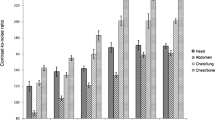Abstract
Background
In our pediatric practice, we have observed qualitatively limited improvement in the image quality of images generated with sinogram affirmed iterative reconstruction (SAFIRE) compared to series generated with filtered back projection (FBP), particularly in cases near or below a CT dose index volume (CTDIvol) of 1-mGy.
Objective
To determine whether the image quality advantage of SAFIRE remains constant across clinically used CT dose levels in an American College of Radiology (ACR) CT accreditation phantom including the lower dose range used in pediatric imaging.
Materials and methods
An exemption from institutional review board approval was obtained for this phantom-based study. An ACR quality phantom was scanned in incremental kV steps and effective tube current intervals. Acquisitions were reconstructed with FBP and SAFIRE strengths of 1, 3 and 5. Image quality measures were calculated including signal-to-noise ratio (SNR), contrast-to-noise ratio (CNR), low-contrast resolution and high-contrast resolution. Peak SNR was also calculated. Descriptive and nonparametric statistics were used to compare these image quality metrics while normalizing to CT dose index (CTDI).
Results
The percent improvement in SNR and peak SNR of SAFIRE reconstructions compared to FBP decreased from about 70% for image sets acquired above a 1.42 mGy CTDI to 25% at a 0.25 mGy CTDI. CNR improvement with SAFIRE did not vary with dose. No significant difference was seen in the low-contrast resolution or high-contrast resolution of SAFIRE images compared to FBP.
Conclusion
SNR did not improve equally after applying SAFIRE across a spectrum clinically used CTDIs. Below a threshold CTDI, the incremental improvement of SAFIRE compared to FBP decreased.








Similar content being viewed by others
References
Thibault J, Sauer KD, Bouman CA et al (2007) A three-dimensional statistical approach to improved image quality for multislice helical CT. Med Phys 34:4526–4544
Image Gently Campaign Overview. http://www.imagegently.org/FAQsMore/CampaignOverview.aspx. Accessed 21 June 2015
United States Nuclear Regulatory Commission (2015) NRC: Glossary -- ALARA. http://www.nrc.gov/reading-rm/basic-ref/glossary/alara.html. Accessed 21 June 2015
Shuman WP (2010) Image Wisely - adaptive iterative reconstruction in CT: What does it do? How can I use it? http://www.imagewisely.org/~/media/ImageWisely%20Files/Imaging%20Physicians/IW_Shuman_ASIR1.pdf. Accessed 21 June 2015
Mayo-Smith WW (2010) Image Wisely protocol design. http://www.imagewisely.org/~/media/ImageWisely%20Files/Imaging%20Physicians/IW%20Mayo-Smith%20Protocol%20Design.pdf. Accessed 21 June 2015
American College of Radiology (2013) CT accreditation phantom instructions. http://www.acr.org/~/media/ACR/Documents/Accreditation/CT/PhantomTestingInstruction.pdf. Accessed 15 June 2015
Botelho MP, Agrawal R, Gonzalez-Guindalini FD et al (2013) Effect of radiation dose and iterative reconstruction on lung lesion conspicuity at MDCT: does one size fit all? Eur J Radiol 82:e726–e733
Christe A, Charimo-Torrente J, Roychoudhury K et al (2013) Accuracy of low-dose computed tomography (CT) for detecting and characterizing the most common CT-patterns of pulmonary disease. Eur J Radiol 82:e142–e150
Desai GS, Fuentes Orrego JM, Kambadakone AR et al (2013) Performance of iterative reconstruction and automated tube voltage selection on the image quality and radiation dose in abdominal CT scans. J Comput Assist Tomogr 37:897–903
Hardie AD, Tipnis SV, Rieter WJ et al (2013) Physician preference between low-dose computed tomography with a sinogram-affirmed iterative reconstruction algorithm and routine-dose computed tomography with filtered back projection in abdominopelvic imaging. J Comput Assist Tomogr 37:932–936
Korn A, Bender B, Fenchel M et al (2013) Sinogram affirmed iterative reconstruction in head CT: improvement of objective and subjective image quality with concomitant radiation dose reduction. Eur J Radiol 82:1431–1435
Oda S, Utsunomiya D, Funama Y et al (2012) A hybrid iterative reconstruction algorithm that improves the image quality of low-tube-voltage coronary CT angiography. AJR Am J Roentgenol 198:1126–1131
Pontana F, Pagniez J, Duhamel A et al (2013) Reduced-dose low-voltage chest CT angiography with sinogram-affirmed iterative reconstruction versus standard-dose filtered back projection. Radiology 267:609–618
Wang R, Schoepf UJ, Wu R et al (2014) Diagnostic accuracy of coronary CT angiography: comparison of filtered back projection and iterative reconstruction with different strengths. J Comput Assist Tomogr 38:179–184
Wang H, Tan B, Zhao B et al (2013) Raw-data-based iterative reconstruction versus filtered back projection: image quality of low-dose chest computed tomography examinations in 87 patients. Clin Imaging 37:1024–1032
Marin D, Nelson RC, Schindera ST et al (2010) Low-tube-voltage, high-tube-current multidetector abdominal ct: improved image quality and decreased radiation dose with adaptive statistical iterative reconstruction algorithm—initial clinical experience. Radiology 254:145–153
Karmazyn B, Liang Y, Ai H et al (2014) Optimization of hybrid iterative reconstruction level in pediatric body CT. AJR Am J Roentgenol 202:426–431
Nie P, Li H, Duan Y et al (2014) Impact of sinogram affirmed iterative reconstruction (SAFIRE) algorithm on image quality with 70 kVp-tube-voltage dual-source CT angiography in children with congenital heart disease. PLoS One 9, e93210
McCollough CH, Yu L, Kofler JM et al (2015) Degradation of CT low-contrast spatial resolution due to the use of iterative reconstruction and reduced dose levels. Radiology 276:499–506
Cody DD, Pfeiffer D, McNitt-Gray MF et al (2012) ACR Computed tomography quality control manual. http://www.acr.org/Education/Education-Catalog/Products/8336734. Accessed 13 Sept 2016
Wuerslin C (2013) DICOM Import GUI. http://www.mathworks.com/matlabcentral/fileexchange/41912-dicom-import-gui/content/DicomImport.m. Accessed 27 Sept 2014
Donald JH (2014) Kruskal-Wallis test. http://www.biostathandbook.com/kruskalwallis.html. Accessed 14 July 2015
Webb A (2003) Introduction to biomedical imaging. John Wiley & Sons Inc., Hoboken
Ghetti C, Palleri F, Serreli G et al (2013) Physical characterization of a new CT iterative reconstruction method operating in sinogram space. J Appl Clin Med Phys 14:4347
Author information
Authors and Affiliations
Corresponding author
Ethics declarations
Conflicts of interest
None
Rights and permissions
About this article
Cite this article
Infante, J.C., Liu, Y. & Rigsby, C.K. CT image quality in sinogram affirmed iterative reconstruction phantom study – is there a point of diminishing returns?. Pediatr Radiol 47, 333–341 (2017). https://doi.org/10.1007/s00247-016-3745-1
Received:
Revised:
Accepted:
Published:
Issue Date:
DOI: https://doi.org/10.1007/s00247-016-3745-1




